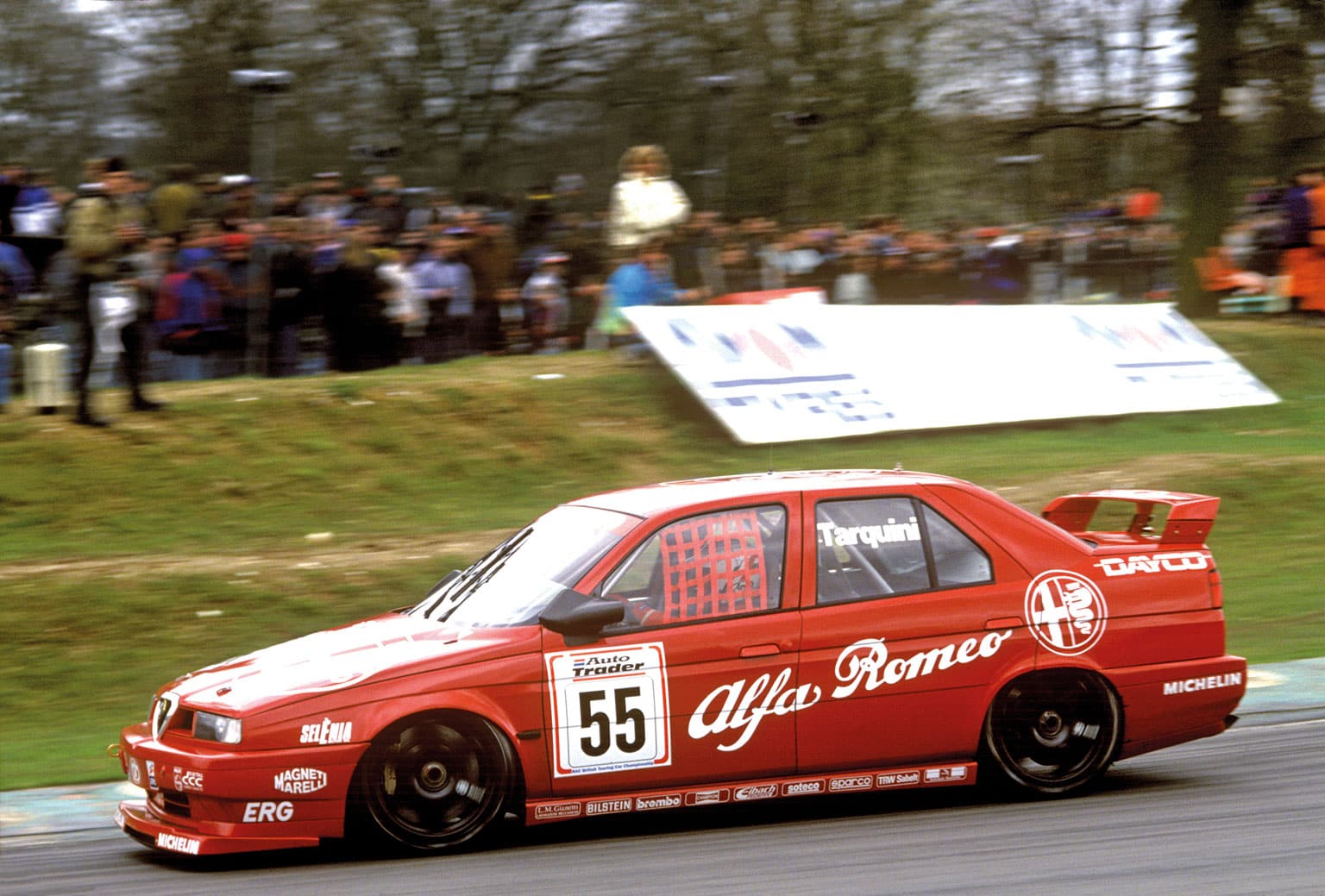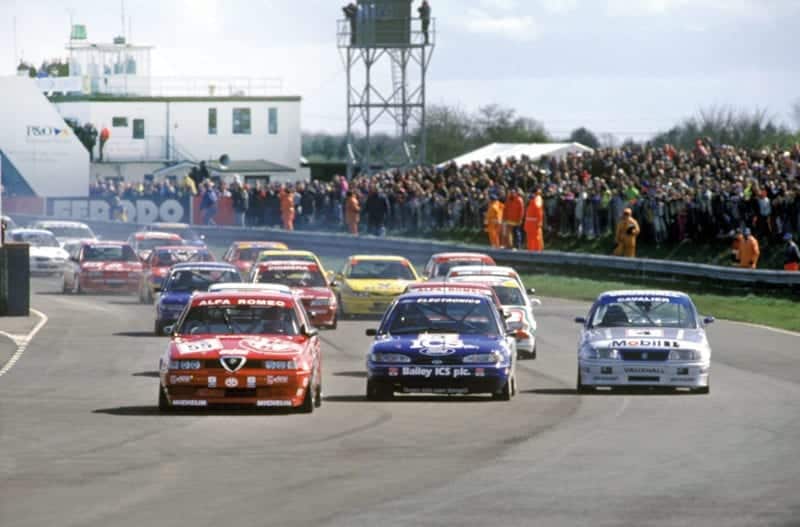Race car buying guide: Alfa Romeo 155 GTA
It may have been a dull road offering, but in racing form the 155 was anything but boring

When it came to the BTCC, with front and rear wings extended, the 155 caused a stir, and cleaned up
Getty
Motor racing has a way of changing perceptions. Success on the track can rejuvenate the appeal of even the most humdrum of models. Racing did exactly this for the Alfa Romeo 155, a model that risked being a flop before its exploits in touring cars gave it a dose of creditability… and notoriety.
The 155 did it all: won championships, spawned homologation specials, revolutionised Super Touring and bent the rulebook as it went.
But before all that, the 155 was actually a culture shock when it was first unveiled in 1992.
Alfa Romeo needed a cash injection in the mid 1980s. Ford was willing to buy a stake, but would very likely shift production away from the home country. Fiat didn’t like this idea, and instead bought Alfa Romeo entirely in 1986, preserving jobs and facilities. Sounds great, apart from that it now meant Alfa was a smaller cog in a much larger company.
The 155 was the first new model unveiled under Fiat ownership. It shared its chassis with the dreary Fiat Tempra and was switched to front-wheel drive, as opposed to the rear-drive staple of independent Alfas. Its boxy lines gave it an excellent drag coefficient, but did little else to turn heads. Until Alfa took it racing.
Over to works race team Alfa Corse, which set about stiffening the chassis by seam-welding them to within an inch of their lives, ditching any brackets or cost-saving parts Fiat had used. The first cars raced in the Italian Superturismo Championship, with Nicola Larini giving the 155 GTA the title in its first year, and there was another success in the Spanish championship. But it was when Alfa decided to enter the British Touring Car Championship for 1994 that things got far more interesting, and controversial.

The 155 GTA was unbeatable on its BTCC debut at Thruxton, and would win the first five races of the season with Tarquini driving
Getty
BTCC homologation regulations at the time demanded that manufacturers create at least 2500 road-going variants of the models they would race, and in that Alfa spotted a loophole.
So Alfa Corse went to work creating a new souped-up 155 called the Silverstone. It did away with the standard 1.8-litre Twin Spark engine, replaced by a block Fiat had been using in rallying, together with a modified cylinder head which was rotated 180 degrees to improve cooling and weight distribution. But the biggest change was in the aero. The Silverstone came with front and rear spoilers. Only small ones, but the clever bit was the adjustable kit that was supplied in the boot that allowed customers to make them much larger.
When fitted, the extended aero provided almost no benefit to the road car, but was transformative for the race car. When Alfa rocked up to the first round of the ’94 BTCC at Thruxton with both the rear wing and chunky splitter fully extended – acting to suck the car down onto the track – more than eyebrows were raised. Gabriele Tarquini was unbeatable for the first five races before Ford finally got a look in.
Alfa’s rivals accused it of ‘taking the mick’ and a flood of protests ensued. And then came the fifth round, at Oulton Park. BTCC officials ordered Alfa to run with the wings retracted. Alfa argued that if the road car could be adjusted that way, so could its race car. It kicked up so much fuss that the team simply packed up and withdrew from the meeting in protest. Alfa returned for the rest of the season, accepting a compromise to run with the wings in place until July, and then retract them. Tarquini won a further three races to waltz to the title.

A widened, more muscular version took on the DTM in 1993, and starred in the International Touring Car Championship
TOCA made spoilers and wings commonplace for the following season, and Alfa lost its edge. The works team went back to Italy, leaving Prodrive with the now under-developed 155, which never won another BTCC race before it was withdrawn at the end of the season.
The 155 also formed the base of a DTM entry. With its bodywork widened and running a 420bhp 2.5-litre V6 engine that revved to a ridiculous 12,000rpm and powered all four wheels, the 155 V6 Ti carried Larini to the DTM title in 1993 and scored a total of 38 race wins before it too was mothballed after 1996.
Alfa Romeo 155 GTA
Price new N/A
Price now £130,000-200,000
Engine 1997cc in-line four Fiat block with Alfa Romeo 16V Q4 Turbo head
Rivals Ford Mondeo, Renault Laguna, Volvo 240 Estate
Verdict As sneaky as it was endearing, this Alfa made history
Market view
The 155 thrived with its race and road specials
The Alfa Romeo 155 GTA is often considered as one of the best-looking touring cars to have competed in the 1990s. Not only did it look good, it went well too, winning the Italian Superturismo Championship, British Touring Car Championship and topping the DTM with a V6 variant.
To celebrate the success, Alfa decided to explore the creation of a road-going race-inspired ultimate version of the 155, which became the 155 GTA Stradale – a 190bhp special with four-wheel drive derived from the Lancia Delta Integrale at its core. Unable to make the figures stack up for production, only one was ever produced, which was due to be sold in 2018 with a guide of £160,000–£200,000 before being withdrawn prior to sale.
There were reportedly 20 155 GTA chassis produced but they have been elusive and sales data is non-existent. In 2016 a 155 D2 Superturismo was estimated at €110-130,000 before a non-sale, and this guide together with that of the unsold Stradale are really the only market indicators. Based on this, we would
expect a guide price of £130,000 – £200,000 if one did come on to the market in the near future.
Robert Johnson,
Classic and Sports Finance
Target deal Alfa Romeo 155 GTA –
£130,000 – £200,000
